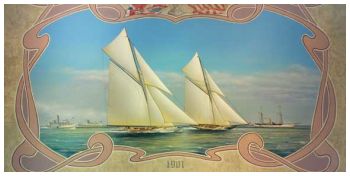Yves GARY Hits: 4207
Category: 1901 : CHALLENGE N°11
 SIR THOMAS LIPTON lost no time in announcing his plans for his second attempt to "lift the cup".
SIR THOMAS LIPTON lost no time in announcing his plans for his second attempt to "lift the cup".
Fife having failed with Shamrock I to make possible the realization of Sir Thomas' high ambition was to be put aside, and George Lennox Watson, Americans learned through the press, would be prevailed on, it was hoped, to accept a commission to design the second challenger.
He was to be given a free hand, the cleverest builders in Britain were to be employed to construct the vessel, and, to quote Sir Thomas, five-pound notes were to be "shoveled on" to spur all concerned to their highest achievements. This, in a period in the cup's history when money was the chief essential of prestige in a challenger, was indeed evidence of Sir Thomas' unconquerable will, and it served well to keep alive interest in the cup contests during the year that elapsed between the return of the defeated Shamrock to England and the arrival of Sir Thomas' second challenge.
|
Royal Ulster Yacht Club, J. V. S. Oddie, EsqR., Dear Sir: The first race to be sailed on Tuesday, Aug. 20, 1901. I, therefore, on behalf of the Royal Ulster Yacht Club, and in the name of Sir Thomas Lipton, rear commodore of the club, challenge to sail a series of match races with the yacht Shamrock II against any other yacht or vessel constructed in the United States of America, for the America cup. The following are the particulars of the challenging vessel: The custom-house measurement will follow as soon as the vessel can be measured for registration. I shall be much obliged if you will cable the receipt of this challenge. Hugh C. Kelly, |
The committee on October 17th, 1900, sent the following acceptance of the Lipton challenge by cable: New York, Oct. 17th, 1900. Hugh C. Kelly, Meeting committee held. Your challenge accepted. Oddie. On Oct. 22d Sir Thomas Lipton requested by cable that starts be made not later than 1 p. m. and that the time limit be six hours instead of five and one-half hours. The committee granted the first request, but not the second. |
Conditions to govern the match were forwarded to the challenging club Dec. 10th, 1900. They called for
|
|
 Sir Thomas Lipton on Jan. 30th, 1901, requested that the yachts be given a one-gun start, that they be measured at the Brooklyn navy yard graving-dock, and that Shamrock be given three weeks to refit at New York in the event of being delayed by stress of weather or other cause. The New York Yacht Club committee replied, Feb. 18th, that it could see no reason for changing the method of starting the races; that it did not control the Brooklyn navy yard dock and therefore was not sure of it when wanted, and deemed it inexpedient to make its use a condition of the match; and agreeing to allow Shamrock three weeks for fitting out after arrival, but the first race to be sailed not later than Aug. 27th. This in substance provided for a possible postponement of the races for a week only, even if Shamrock arrived less than three weeks before that date.
Sir Thomas Lipton on Jan. 30th, 1901, requested that the yachts be given a one-gun start, that they be measured at the Brooklyn navy yard graving-dock, and that Shamrock be given three weeks to refit at New York in the event of being delayed by stress of weather or other cause. The New York Yacht Club committee replied, Feb. 18th, that it could see no reason for changing the method of starting the races; that it did not control the Brooklyn navy yard dock and therefore was not sure of it when wanted, and deemed it inexpedient to make its use a condition of the match; and agreeing to allow Shamrock three weeks for fitting out after arrival, but the first race to be sailed not later than Aug. 27th. This in substance provided for a possible postponement of the races for a week only, even if Shamrock arrived less than three weeks before that date.
